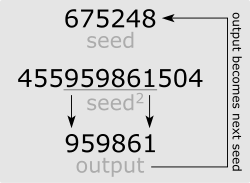Middle-square method


In mathematics, the middle-square method is a method of generating pseudorandom numbers. In practice it is not a good method, since its period is usually very short and it has some severe weaknesses, such as the output sequence almost always converging to zero.
The method was invented by John von Neumann, and was described at a conference in 1949.[1]
To generate a sequence of 4-digit pseudorandom numbers, a 4-digit starting value is created and squared, producing an 8-digit number. If the result has fewer than 8 digits, leading zeroes are added to compensate. The middle 4 digits of the result would be the next number in the sequence, and returned as the result. This process is then repeated to generate more numbers.
For a generator of n-digit numbers, the period can be no longer than 8n. If the middle 4 digits are all zeroes, the generator then outputs zeroes forever. If the first half of a number in the sequence is zeroes, the subsequent numbers will be decreasing to zero. While these runs of zero are easy to detect, they occur too frequently for this method to be of practical use. The middle-squared method can also get stuck on a number other than zero. For n = 4, this occurs with the values 0100, 2500, 3792, and 7600. Other seed values form very short repeating cycles, e.g., 0540 → 2916 → 5030 → 3009. These phenomena are even more obvious when n = 2, as none of the 100 possible seeds generates more than 14 iterations without reverting to 0, 10, 50, 60, or a 24 ↔ 57 loop.
In the 1949 talk, Von Neumann quipped that, "Any one who considers arithmetical methods of producing random digits is, of course, in a state of sin." What he meant, he elaborated, was that there were no true "random numbers", just means to produce them, and "a strict arithmetic procedure", like the one described above, "is not such a method". Nevertheless he found these methods hundreds of times faster than reading "truly" random numbers off punch cards, which had practical importance for his ENIAC work. He found the "destruction" of middle-square sequences to be a factor in their favor, because it could be easily detected: "one always fears the appearance of undetected short cycles".[1] Nicholas Metropolis reported sequences of 750,000 digits before "destruction" by means of using 38-bit numbers with the "middle-square" method.[2]
Fiction
The book The Broken Dice by Ivar Ekeland gives an extended account of how the method was invented by a Franciscan friar known only as Brother Edvin sometime between 1240 and 1250.[3] Supposedly, the manuscript is now lost, but Jorge Luis Borges sent Ekeland a copy that he made at the Vatican Library. The story has sometimes been repeated as true, but on inspection it is clearly a fantasy in the style of Borges.
References
- 1 2 The 1949 papers were not reprinted until 1951. John von Neumann, “Various techniques used in connection with random digits,” in A.S. Householder, G.E. Forsythe, and H.H. Germond, eds., Monte Carlo Method, National Bureau of Standards Applied Mathematics Series, vol. 12 (Washington, D.C.: U.S. Government Printing Office, 1951): pp. 36-38.
- ↑ Donald E. Knuth, The art of computer programming, Vol. 2, Seminumerical algorithms, 2nd edn. (Reading, Mass.: Addison-Wesley, 1981), ch. 3, section 3.1.
- ↑ Ivar Ekeland (15 June 1996). The Broken Dice, and Other Mathematical Tales of Chance. University of Chicago Press. ISBN 978-0-226-19992-4.